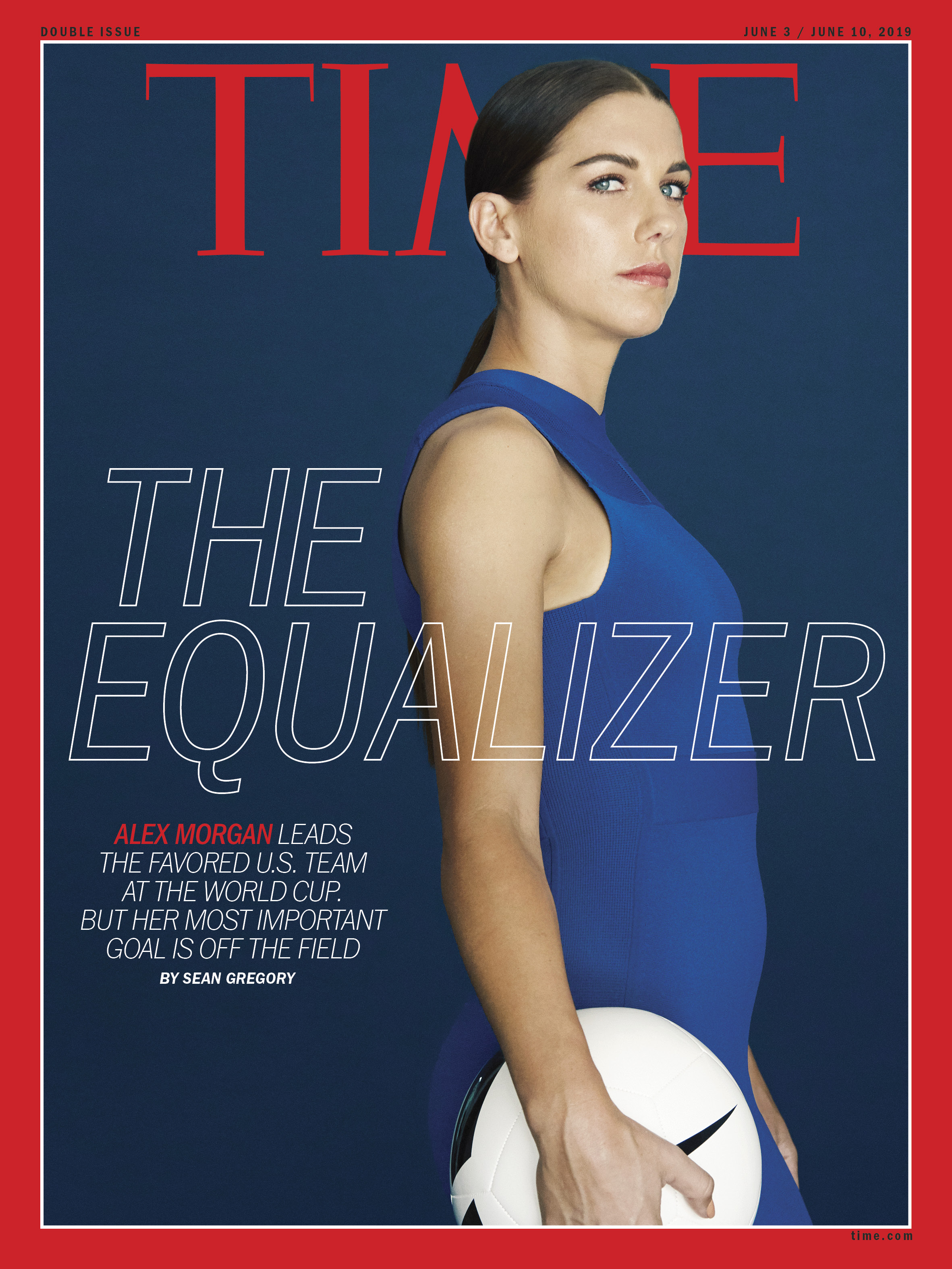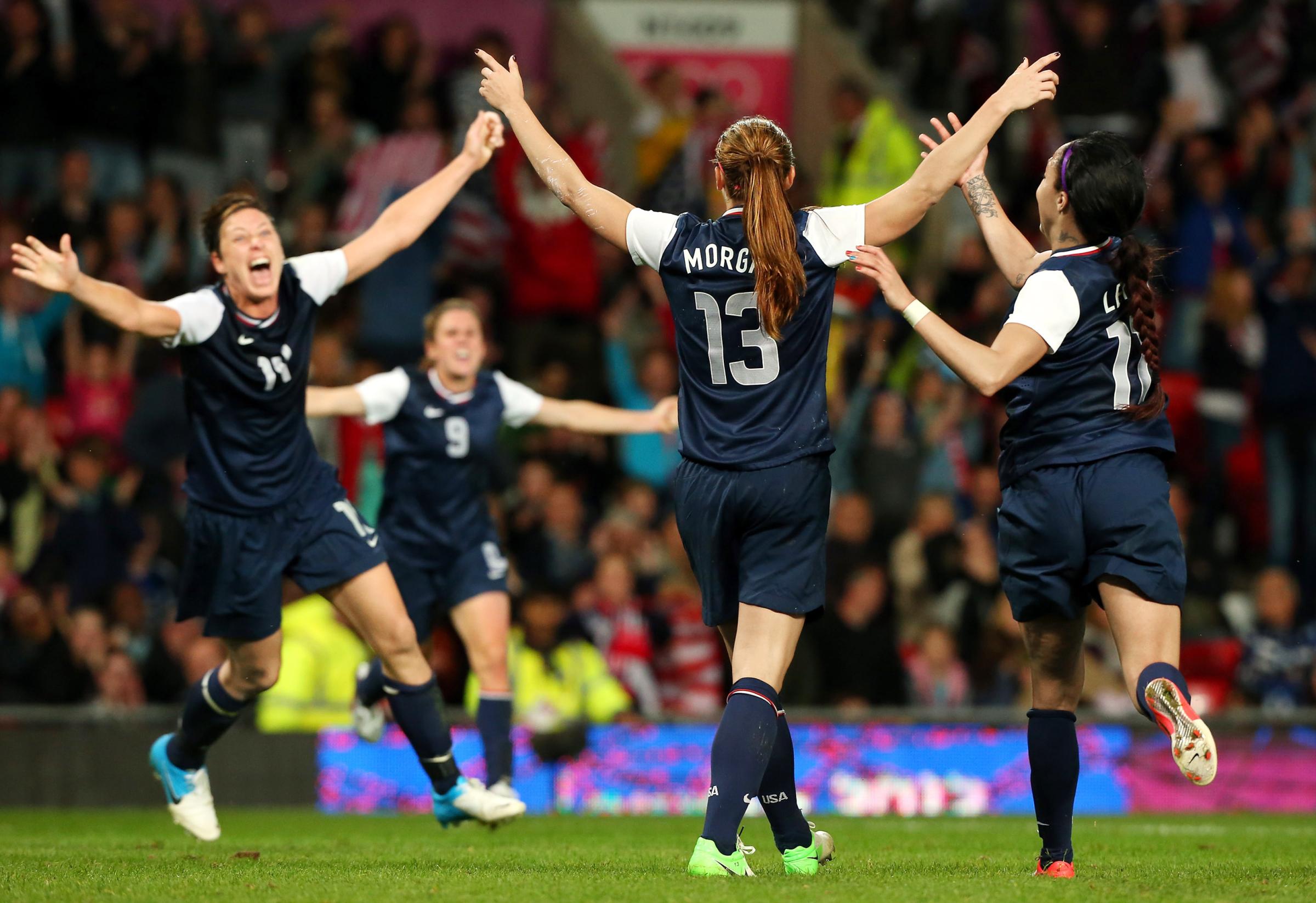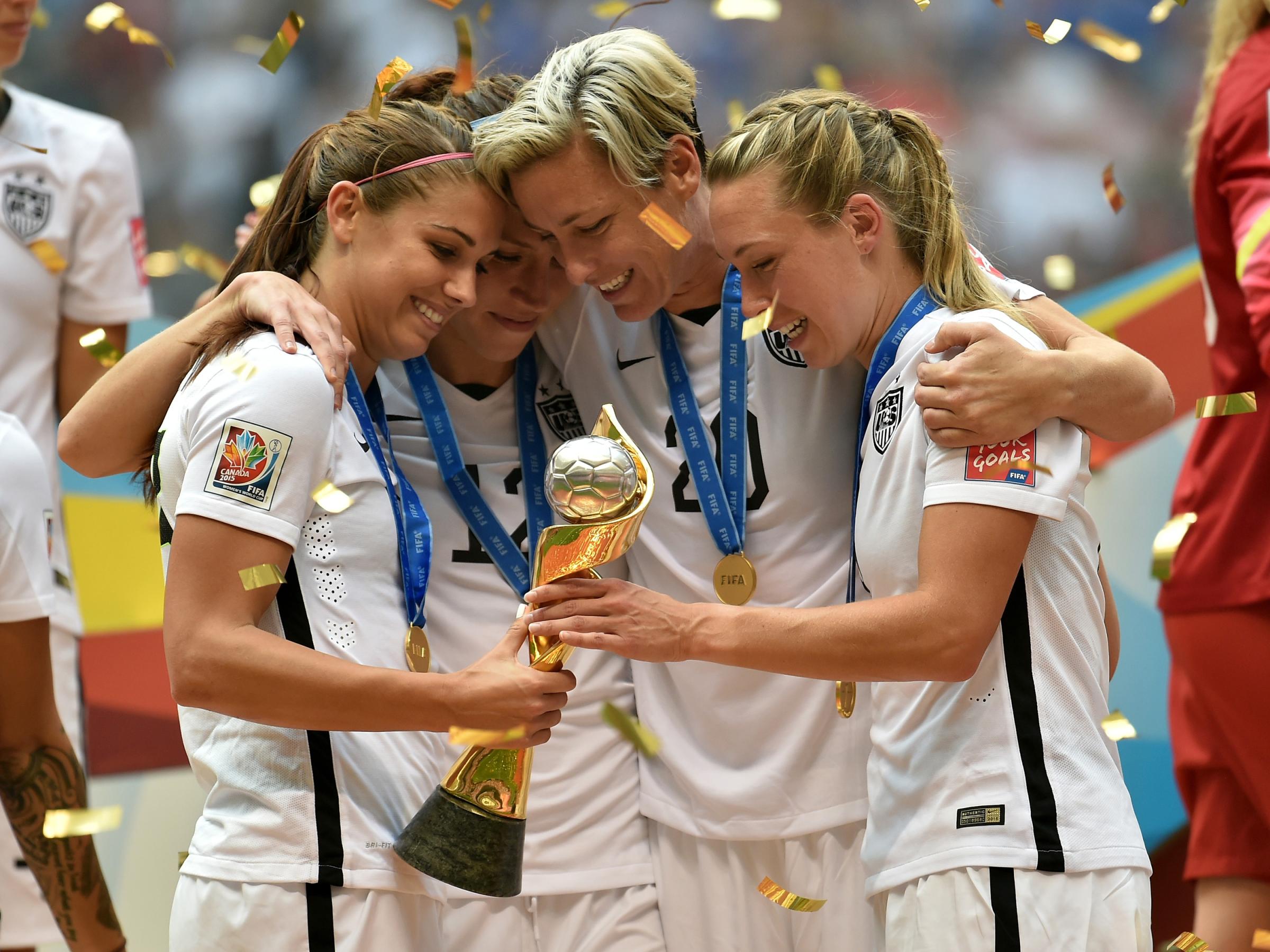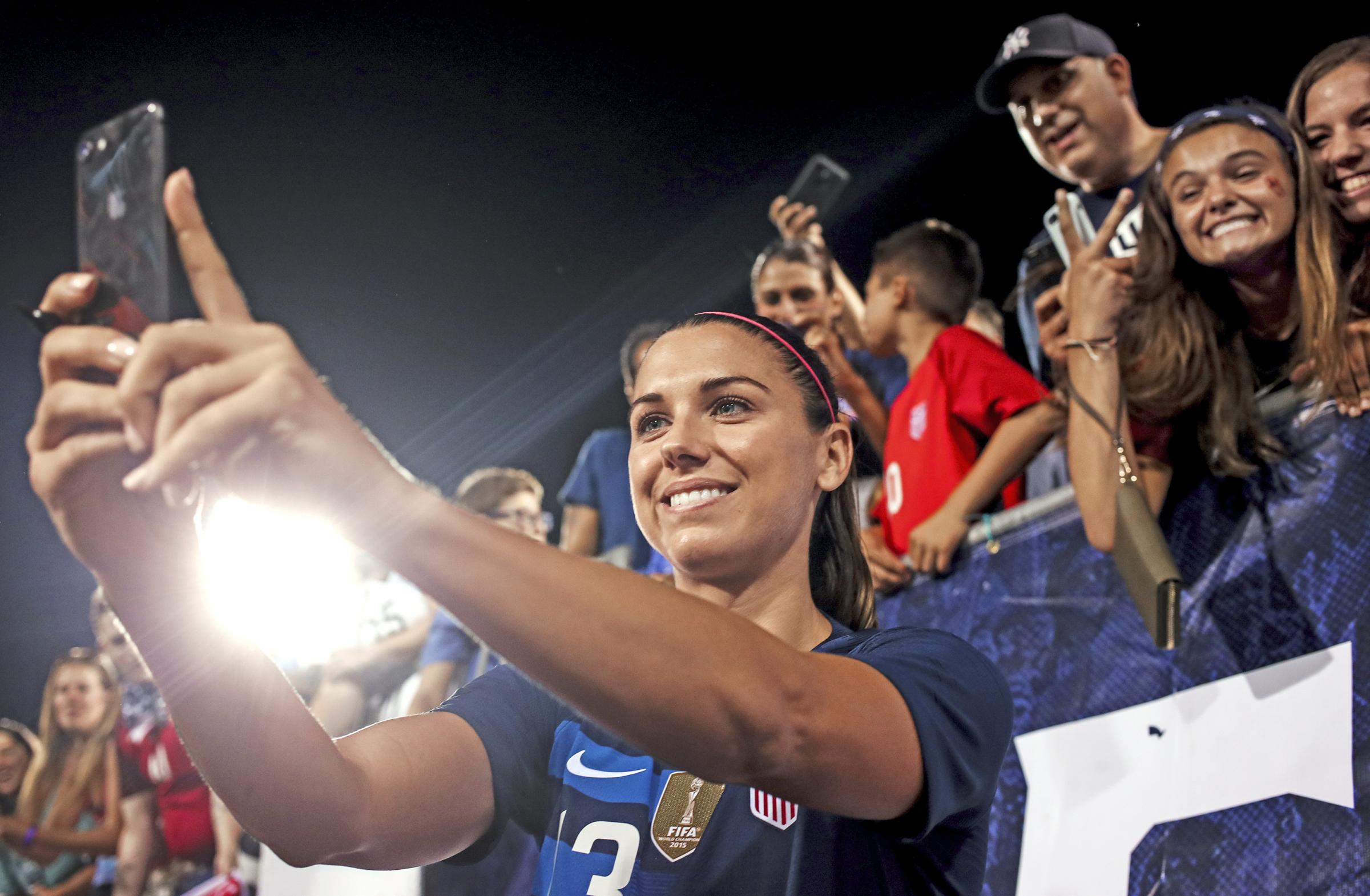On a drizzly spring evening in New York City, Alex Morgan fixes her gaze on the golf ball at her feet, cocks her arms and then propels them forward with effortless power. The ball leaps off the tee and sails toward the netting between the tee and the Hudson River 200 yd. away. “This is nice,” Morgan says, exhaling between swings. “Really nice.”
The driving range is a favorite escape for Morgan, but she’s spending less and less time there–even as she needs the release more than ever. The reigning U.S. women’s soccer player of the year, Morgan is the sport’s most marketable American star since Mia Hamm and the linchpin of Team USA’s bid to clinch a second consecutive World Cup title this summer. She leads the U.S. into the tournament, which begins on June 7 in France, facing outsize expectations both on the field and off.
As the defending champions and top-ranked team, the Americans are favored to win. But the competition is historically tough. When the U.S. hosted the landmark 1999 World Cup, which led tens of thousands of girls to sign up for youth soccer leagues, only a few countries were considered contenders. Traditional soccer powers like France, England and Spain didn’t even qualify. Now, thanks in part to increased investment from soccer governing bodies and their corporate backers, many more have a real shot in the tournament, which now has 24 teams, up from 16 two decades ago.

“This is the first time I have ever been able to name potential winners on more than one hand,” says former U.S. player Julie Foudy, an ESPN analyst, who sees the U.S., France, Germany, Australia, Japan, England and Sweden as title threats. “Absolutely, this is the most competitive World Cup I have seen.”
Interest should be particularly high in the U.S., where the women’s team not only outperforms the men’s team on the field–the men failed to even qualify for last year’s World Cup–but has outdrawn it too. Four years ago, some 25 million people watched the women’s team beat Japan in the World Cup final–a record U.S. audience for any soccer game.
But the team’s success highlights glaring inequities. Despite the popularity of the women’s team, the men are positioned to make substantially more money. And so on March 8, International Women’s Day, the U.S. players took the unprecedented step of filing a federal gender-discrimination lawsuit against the United States Soccer Federation, the national governing body for the sport. Morgan’s name was listed first in the suit, which accuses U.S. Soccer of paying “only lip service to gender equality.” (The federation, in a legal filing responding to the complaint, denied unlawful conduct, attributing any alleged pay discrepancies to “differences in the aggregate revenue generated by the different teams and/or any other factor other than sex.”)
“Eventually, you just have to take a stand,” Morgan says while riding in an Uber from her New York hotel to the driving range. “How come we’ve had to fight this whole time, year after year?”
Her stand has inspired other women’s teams around the world to push for equal treatment and has transformed the U.S. women into a cause larger than soccer. At a Los Angeles exhibition game in April, the actors Jessica Chastain, Eva Longoria, Jennifer Garner, Uzo Aduba and Natalie Portman attended with T-shirts that read Time’s Up Pay Up. At a time of almost paralyzing political division, the World Cup has the potential to be a welcome national distraction, a respite from presidential politicking and cable-news sniping.
“A win for this team is a win for women everywhere,” says former U.S. captain Abby Wambach. “If other women in the business world, in parenting, see these women stepping up and betting on themselves, it gives them the power to want to do it for themselves. And that, my friend, is how the world actually changes.”
No pressure or anything, not that Morgan wasn’t feeling plenty already. Morgan, 29, is the face of Team USA–her steely gaze will be plastered on billboards and dancing across screens in commercials for Coca-Cola, Nike and Secret deodorant. Her millions of followers on Instagram and Twitter give her one of the largest social-media imprints of any female athlete in the world. She starred in a Nickelodeon movie for kids, Alex & Me; wrote a series of books for middle schoolers that was made into an Amazon TV series; and has shared a stage with Taylor Swift.
But Morgan, who in April joined Hamm and Wambach as the youngest U.S. players to score 100 career international goals, has never dominated the World Cup. She was a breakout rookie in a losing effort in 2011, and was hobbled by injuries in 2015 when Carli Lloyd’s heroics powered the U.S. to victory. This year is the best chance for America’s best player to make her mark on the world’s most prestigious tournament–while showing that she should be paid the same as any man for doing it.

“We have to do more in general–we have to be the athlete, we have to be the role model, we have to lead the way for the next generation,” Morgan says. “Are male athletes doing that? Are they thinking about anyone other than themselves? I don’t know. We do have more than one job within this role, and are getting paid much less.”
So it’s understandable if the weight of it all weighs on Morgan as she hacks away at the driving range. After a few crisp swings, she whiffs, missing the ball completely. “I’m going back to my 7-iron,” she says when her driver catches air. All that looms in the background is national unity, gender equality and Morgan’s professional legacy. “You can’t think about it,” she says. “But you can’t not.”
Leading the fight for equal pay in sports was far from the mind of the 8-year-old Morgan when she left a Post-it for her mother, Pam, at their home in Diamond Bar, Calif., a suburb east of Los Angeles. “Hi Mommy!” Morgan wrote on a note Pam still has. “My name is Alex and I am going to be a professional athlete for soccer!” She signed it “Ali Cat.”
The certainty was surprising. Unlike most promising young soccer players, Morgan avoided the high-pressure Southern California youth circuit and played many different sports as a kid. Her competitiveness was honed in fierce board games with her parents and two older sisters. “Alex strove not to be the loser,” says her father Michael, a retired masonry contractor. “Because she knew she was going to get party-danced around.”
Morgan began playing elite travel soccer at 14, years after many of her contemporaries. She credits playing a range of sports with preventing her from burning out. “When I went to soccer practice, I was really excited because I hadn’t been there in four days,” says Morgan. She worries that today’s youth system is also pricing out potential soccer stars and is counterproductive to America’s future competitiveness.
From our Partner: IBM on how AI can drive equality
Morgan’s speed and knack for scoring earned her a soccer scholarship to the University of California, Berkeley, where she graduated with a degree in political economy and met her future husband, Los Angeles Galaxy midfielder Servando Carrasco, who also played for the school. Morgan excelled on the pitch for Cal and was named to the U.S. Under-20 team, which functions as a feeder for the top national team. After helping lead the U.S. to the 2008 Under-20 World Cup title with a brilliant left-footed goal in the final, Morgan was called up to the senior squad.
Her impact was immediate. Morgan scored a key goal against Italy to help the U.S. qualify for the 2011 World Cup, and she emerged as a go-to substitute in the tournament. Undaunted by soccer’s biggest stage, Morgan scored in both the semis and the finals in her first World Cup, which the U.S. lost in heartbreaking fashion to Japan.
The performance endeared Morgan to her older teammates, who gave her the nickname Baby Horse. “She ran so fast and has a very specific gait,” says former teammate Shannon Boxx. “Baby horses are little unsteady with her legs, and we kind of saw that.” Morgan disliked the name but knew better than to complain. “When you’re young and have no leverage on the team, you’re like, Sure, I’ll take Baby Horse,” she says. “But after two or three years, I was like, O.K., it’s funny, but let’s move on.”
Baby Horse became a key cog in the team’s gold-medal run at the 2012 Olympics. Her winning goal in the semifinal against Canada–a header seconds before time expired–has become soccer lore. “What’s unique about Alex is the closer she gets to the goal, the slower the game happens for her,” says Wambach, who has written a new book called Wolfpack: How to Come Together, Unleash Our Power, and Change the Game. “She can see the rotation of the ball, and imagine and create a situation where most players would be like, ‘Oh, this is shut down.’ It’s like something else inside of her body just goes into a natural state of flow that allows her to score goals. Her power is unlike anything I’ve ever seen.”

The Olympics made Morgan into a star. She appeared in McDonald’s ads with LeBron James and helped the fledgling National Women’s Soccer League (NWSL) get off the ground by joining the Portland Thorns for the inaugural 2013 season. Buoyed by endorsement deals, her annual income grew into the seven figures–far beyond that of any other top U.S. women’s player. She published an autobiography in 2015 and began writing The Kicks, a best-selling kids’ fiction series with a 10th installment coming in June.
A run of knee and ankle injuries, however, slowed Morgan’s ascent. She was hobbled by knee problems at the 2015 World Cup and isn’t proud of her individual showing despite the team’s win. “I don’t feel like I met my goals,” Morgan says in late February at a Philadelphia hotel, where the national team was staying for a game against Japan. “In the first half of the final, I was just gasping, dead. My legs would not go. I wasn’t thinking about how to beat my opponent and be that fearless attacker. I was thinking about how to be pain-free.” A year later at the Rio Olympics, Sweden bounced the U.S. in the quarterfinals, the earliest the U.S. women’s team has ever been eliminated from a major international tournament.

It was a low moment. Morgan needed to rekindle her passion for the game. So she did what many other Americans in search of inspiration have done: move to France. After being courted publicly by Jean-Michel Aulas, the president of the French club team Olympique Lyonnais, Morgan agreed to join the squad for its 2017 season. Lyon has become a powerhouse in the women’s game, dominating the competition by attracting top players from around the world, paying them more and treating them like a men’s team. This simple, seemingly intuitive idea is radical in professional soccer, where the men’s teams of top clubs are routinely afforded more perks than their women’s sides. “It was something I needed at the time,” says Morgan. “To focus on soccer solely and entirely, without having my family, without having my friends, not having anyone but the team I went to play for.”
Lyon soared with Morgan, winning the league championship, the French Cup and the Women’s Champions League title–a feat known as the treble. More importantly, Morgan rediscovered the joy of playing. She began meditating and doing yoga, and soon switched to a vegan diet after deciding it was unethical to eat meat.
Save for exalting the beeflike Impossible Burger, Morgan couches her new regimen as a personal choice and keeps the proselytizing to a minimum. But over a dinner of artichokes and stuffed peppers in New York, she says the change has boosted her energy on the field. It’s impossible to argue with the results: from August 2017 through the end of last year, Morgan scored an incredible 25 goals in 26 games. She is decidedly no longer Baby Horse. “She has worked to promote the game, promote her team and promote herself,” says Hamm, who still casts a long shadow over women’s soccer. “She’s done an amazing job.”

As Morgan has developed into America’s leader on the field, she has strengthened her voice beyond it. Among the pro-athlete orthodoxies she’s willing to break: don’t criticize management, and steer clear of politics. After Major League Soccer’s Orlando City team declined to retain her husband, Carrasco, while Morgan was playing for the Orlando women’s team, she called out the clubs’ shared management for breaking what she says was a deal. “We were told it was going to be a long-term relationship between the club and us,” Morgan says now. “When you promote a business acting as a family, I would expect to be given that treatment you promote.”
President Donald Trump is another target. “I don’t stand for a lot of things the current office stands for,” Morgan says. She’s particularly upset about the Administration’s policy of separating migrant families at the southern border, noting that her husband’s family is from Mexico. Indeed, if Trump invites the team to the White House after the World Cup, Morgan says she won’t go. If that turns anyone off, so be it.
“We don’t have to be put in this little box,” Morgan says between sips of red wine at dinner. “There’s the narrative that’s been said hundreds of times about any sort of athlete who’s spoken out politically. ‘Stick to sports.’ We’re much more than that, O.K.?”
A national team doesn’t simply decide to sue its governing body on a whim. The roots of the equal-pay fight go back decades. In the early 1990s, the team flew to a tournament in China in cramped economy seats adjacent to the smoking section. “We were pretty much smoking for 13 hours,” says Hamm, who played on the team from 1987 to 2004. Players recall staying in roach-infested rooms and taking the hotel shuttle bus to a game. “We sit now and we have to laugh,” says Hamm. “If you didn’t, you’d cry.”
Conditions for the team have vastly improved since the 1990s, and U.S. Soccer has invested far more in women’s soccer than most other countries. But plenty of indignities linger.
At one stop on the 2015 World Cup victory tour, a series of 10 exhibition games across the country meant to celebrate the team (and fill U.S. Soccer’s coffers), players were shocked by the conditions at Aloha Stadium near Honolulu. Rocks filled the turf. In some sections, the aging field was pulling up out of the ground. The team felt it was unsafe and refused to play. U.S. Soccer agreed and canceled the game, but it rankled the players that it wouldn’t have happened if they hadn’t spoken out.
“It falls on us sometimes to decide what’s just, what’s unjust,” says Morgan. “We as players shouldn’t have to make those decisions. But I’m happy we came together and did.”
It was a lesson that informed the decision of five of the team’s star players, in 2016, to file a complaint over inequity in pay and bonuses with the federal Equal Employment Opportunity Commission. “We realized that just because we had success without being given what we deserve, doesn’t mean we didn’t deserve it,” says Morgan. “That was like a flip of the switch.”
In April 2017, the players signed a new collective-bargaining agreement with U.S. Soccer. As part of the deal, the players won control of certain licensing and marketing rights. They partnered with the NFL Players Association and the WNBA Players Association to form REP Worldwide, a new licensing-representation company, in late 2017. REP expects to sign some 25 licensees–for things like jerseys, scarves and digital collectibles–for the women’s soccer players by the start of the World Cup. REP says the players can expect between $1 million and $2 million in net royalties by the end of 2020.
Despite these gains, the women often end up with less than the men–and that includes the coaches. For the fiscal year ending in March 2018, women’s head coach Jill Ellis received $318,533 in total compensation–making her the 10th highest paid employee at U.S. Soccer. Jürgen Klinsmann, who was fired as U.S. men’s coach in 2016, still received $3.35 million. Bruce Arena, who replaced Klinsmann and oversaw the failed effort to qualify for the 2018 World Cup, got $1.27 million. Even the coach of the Under-20 men’s team made more than Ellis. (U.S. Soccer says she has since received a six-figure raise that will be disclosed in next year’s tax filings.)

“It’s devastating to see a male coach who hasn’t been coach of the men’s team for more than two years still be paid significantly more than Jill, who has a World Cup title on her résumé,” says Morgan. “It’s terrible.”
This long history was on the players’ minds when they decided to sue their employers in an effort to close the pay gap once and for all. As the team’s top player and biggest name, Morgan agreed to be listed first in the complaint.
“I’m not sure our team would have done that three months before the World Cup,” says Foudy, who played on the seminal 1999 U.S. team that won the World Cup on home soil. “We wouldn’t want all that noise. I respect that they’re willing to absorb all that. It’s courageous.”
According to the complaint, U.S. Soccer “rejected requests for compensation for the WNT players that would have been at least equal to that afforded to the male MNT players.”
U.S. Soccer has argued that since the organization signed different collective-bargaining agreements with the men’s and women’s teams, the gender comparisons are unfair. Women’s national team players, for example, can now receive salaries of around $170,000 from the federation if they also play in the NWSL, which U.S. Soccer helps finance. The U.S. provides no such base pay to the men’s players, since they can earn contracts playing in pro leagues that are far more lucrative than organizations like the NWSL. According to U.S. Soccer, the men are eligible for higher per-game bonuses because the federation pays them on a per-game basis as opposed to a salary. For example, the men receive $17,625 for winning an exhibition game, or friendly, against a top-10 team or Mexico; under the 2017 collective-bargaining agreement, the women get $8,500 for a friendly victory over a top-4 team or Canada. Some of the pay gap also comes from the stark differences in World Cup performance bonuses from FIFA. FIFA awarded $9 million to the U.S. after the men reached the round of 16 in the 2014 World Cup, while the federation received $2 million after the women won it all in 2015. FIFA has attributed these differences to the larger revenues generated by the men’s tournament.
The litigation is expected to take months to play out. U.S. Soccer is attempting to get the case dismissed, while the players may try to force a settlement. Whatever the legal result, the U.S. women have already secured a victory. Their push for more equitable benefits has inspired other female athletes to fight for their fair share.
“The women’s soccer team, in my opinion and the opinion of many of my teammates, continues to lead the way in advancing women’s sports,” says Meghan Duggan, a member of the 2018 Olympic gold medal–winning U.S. hockey team, which threatened to boycott the world championships in 2017 unless their pay improved. (The team struck a new agreement with USA Hockey before the tournament began.) The U.S. team’s stand has set off a chain reaction in women’s soccer. The Danish women’s national team boycotted a World Cup qualifying match in October 2017; it has since signed a four-year collective-bargaining agreement that included increased investment in women’s soccer. After refusing to promote their appearance in the 2017 Euro tournament finals, Scotland’s female players signed the first collective-bargaining agreement with their federation. And Norway’s women achieved pay parity with the men.
In some ways, the equality fight is being won piecemeal. The foodmaker Luna Bar pledged to pay each of the U.S. women who made the World Cup team $31,250, to make up for differences in roster bonuses. Nike has launched a national ad campaign called “Dream With Us,” built around Morgan and the women’s team as inspirational figures. Still, relying on corporate largess to compensate for a cultural double standard is halting progress at best.
“When I was playing, 75% of my money came from endorsements, 25% came from playing. I would love for that to be flipped,” says Hamm. “It’s frustrating that we’re still having these conversations. I’m proud of the women that they’re saying we’re not taking no for an answer.”
To Morgan, the best way to state her case is on the field. She sees another World Cup win as essential to boosting public support for equal pay. “Seeing women supporting other women on a grander level is pretty unique,” she says. “We need to capitalize on that now.”
The path to victory in France, however, is narrower than ever. The host team is hungry for its first title; the last time a World Cup was held in France, in 1998, the men won at home. England, which reached the semifinals in 2015, won the SheBelieves Cup in March. And Japan, which has reached the finals of the past two World Cups, remains a threat. The U.S. opens against Thailand, on June 11, and must fare well against the other teams in its group, Chile and Sweden, to advance.
To prepare, Morgan has studied video of her performances with her personal coach and worked on a bending left-footed shot, from outside the 18-yd. box. She’s also taking extra care of her body. When the national team introduced high-tech wristbands to monitor rest quality, Morgan ditched the device. “I swear when I started wearing it, I stopped sleeping well,” Morgan says. “After two nights, I was like, F this.”
Back at the driving range, the sky clears over the Hudson River as Morgan talks about her ability to compartmentalize. Among the things on her mind is an ambition to launch a media company for girls and women who love sports. But she has balanced performance with the demands of stardom as well as any athlete before her. So why not expect more of the same this summer? “If we do our job,” she says, “people will be captivated. This can be something greater and bigger than there’s ever been before.”
Morgan takes one last swing with her driver. Whack. Her ball flies high and long, straight toward the sunset.
Correction, May 23:
The original version of this story misstated the head coach of the Swedish women’s national team. It is Peter Gerhardsson. Pia Sundhage no longer coaches the team.
More Must-Reads from TIME
- Donald Trump Is TIME's 2024 Person of the Year
- Why We Chose Trump as Person of the Year
- Is Intermittent Fasting Good or Bad for You?
- The 100 Must-Read Books of 2024
- The 20 Best Christmas TV Episodes
- Column: If Optimism Feels Ridiculous Now, Try Hope
- The Future of Climate Action Is Trade Policy
- Merle Bombardieri Is Helping People Make the Baby Decision
Write to Sean Gregory at sean.gregory@time.com